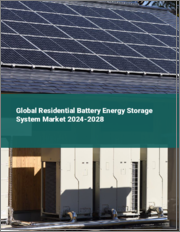
|
시장보고서
상품코드
1327639
세계의 주택용 에너지 저장 시스템(ESS) 시장(2023-2030년)Global Residential Energy Storage System (ESS) Market 2023-2030 |
||||||
세계 주택용 에너지 저장 시스템(ESS) 시장은 예측 기간 동안 23.8%의 CAGR로 급성장할 것으로 예상됩니다. 중앙집권적이지 않고 디지털화된 지속가능한 에너지 시스템을 장려하는 정부 정책은 세계 주택용 ESS 시장의 성장을 촉진하는 데 중요한 역할을 하고 있습니다. 이러한 성장에 크게 기여하는 것은 스토리지와 결합된 태양광 의무화 시행입니다. 예를 들어, 2020년 초에 시행된 캘리포니아주의 태양광발전 의무화가 대표적입니다. 이는 모든 주택(3층 이하)에 가정의 연간 에너지 수요를 평균적으로 상쇄할 수 있을 만큼의 태양광발전(PV) 시스템을 의무적으로 설치하도록 하는 것입니다.
이 정책에 따라 주택 소유자는 의무화된 PV "크레딧"을 "저장" 크레딧으로 교환할 수 있는 기회가 있어 저장 솔루션의 채택을 더욱 장려합니다. 또한 종합적인 건물 개조 및 효율 기준도 시장 확대의 한 요인으로 작용하고 있습니다. 예를 들어, 이탈리아는 개보수 촉진책과 연간 세금에서 PV 및 저장 비용의 110.0%를 공제하는 옵션을 결합하고 있습니다. 주택용 축전지 분야는 솔라파워유럽이 최초로 발표한 '유럽 주택용 축전지 시장 전망 2020-2024'에서 알 수 있듯이 높은 잠재력을 바탕으로 괄목할 만한 성장세를 보이고 있습니다. 이 시장의 연간 성장률은 57.0%에 달하며, 지난해 96,000개 시스템, 총 745MWh가 설치됐습니다.
전력저장장치에 대한 세제 혜택은 전 세계 주택용 ESS 시장 성장에 유리한 기회를 제공할 것으로 예상됩니다. 예를 들어, 이탈리아에서는 연간 과세 금액에서 기준 금액의 50.0%(즉, 4,000유로)를 공제할 수 있는 옵션이 있어 전력 저장 솔루션에 대한 투자를 더욱 촉진하고 있습니다. 네덜란드에서는 투자금액을 3년간 감가상각할 수 있도록 허용하고 있습니다. 전반적으로 이러한 지원 정책과 혜택은 전 세계 주택용 ESS 시장 확대를 촉진하고 있으며, 상당한 성장 잠재력을 가진 유망한 분야로 평가받고 있습니다.
부문별 전망
지역별 전망
세계 주택용 ESS 시장은 북미(미국 및 캐나다), 유럽(이탈리아, 스페인, 독일, 프랑스, 기타), 아시아태평양(인도, 중국, 일본, 한국, 기타), 기타 지역(중동 및 아프리카, 라틴아메리카) 등 지역별로 세분화되어 있습니다. 그 중에서도 유럽은 예측 기간 동안 상당한 CAGR로 성장할 것으로 추정됩니다. 유럽의 많은 국가에서 가정용 축전지가 매우 널리 보급되어 있습니다. 주요 시장에서는 주택용 태양광 시스템에 저장장치 설치율이 90%를 넘어섰습니다.
이러한 동기는 여러 가지가 있지만, 모두 감정과 경제성이라는 두 가지 주요 원동력으로 요약할 수 있습니다. 2023년 6월, 캐나다 솔라는 Intersolar Europe 2023에서 이터널 플래닛이 자체 설계하고 개발한 최초의 주택용 전력 저장 시스템인 EP Cube를 발표하였습니다. EP Cube는 정전 시 전력 공급을 자동화하여 전력망이 중단된 상태에서도 고출력 가전제품이 정상적으로 작동할 수 있도록 하는 EP Cube를 통해 주택 소유자는 전력 공급 부족이나 불안정성에 대해 걱정할 필요가 없습니다. 걱정할 필요가 없습니다. 이러한 신흥국 시장 개척은 이 지역의 시장 성장에 더욱 기여하고 있습니다.
아시아태평양은 세계 주택용 ESS 시장에서 상당한 점유율을 차지할 것으로 예상
아시아태평양은 중국, 인도, 일본 등의 국가에서 재생에너지 부문의 성장으로 인해 세계 주택용 ESS 시장에서 상당한 시장 점유율을 차지할 것으로 예상됩니다. 그 중에서도 중국과 인도는 태양광 패널 산업에서 두각을 나타내고 있습니다. 특히 중국은 태양광발전 설비와 태양광 패널 생산 측면에서 큰 잠재력을 가지고 있습니다. 국제에너지기구(IEA)에 따르면, 중국은 2019년 205GW를 넘어 전 세계 설치량의 35.0% 이상을 차지하며 가장 큰 태양광발전 설치 용량을 자랑합니다. 또한 중국은 세계 최대 태양광 장비 제조업체로 선두를 달리고 있습니다. 중국의 태양광 패널 보급은 주택용 ESS 수요에 큰 기여를 하고 있습니다. 이러한 장비를 통해 소비자들은 태양이 없는 시간대에도 태양광발전을 사용할 수 있어 필요할 때 더 많은 자가 발전된 청정 전력을 사용할 수 있습니다. 따라서 이 지역 전체에서 태양광 패널을 대규모로 채택하는 것이 이 지역 시장을 주도하는 중요한 요인으로 작용하고 있습니다.
목차
제1장 보고서 개요
- 업계 현황 분석과 성장 가능성 전망
- 조사 방법과 툴
- 시장 내역
- 부문별
- 지역별
제2장 시장 개요와 인사이트
- 조사 범위
- 애널리스트의 인사이트와 현재 시장 동향
- 주요 조사 결과
- 추천사항
- 결론
제3장 경쟁 상황
- 주요 기업 분석
- Panasonic Holdings Corp.
- 개요
- 재무 분석
- SWOT 분석
- 최근의 동향
- Sonnen GmbH
- 기업 개요
- 재무 분석
- SWOT 분석
- 최근의 동향
- Tesla Inc.
- 개요
- 재무 분석
- SWOT 분석
- 최근의 동향
- VARTA AG
- 개요
- 재무 분석
- SWOT 분석
- 최근의 동향
- 주요 전략 분석
제4장 시장 세분화
- 주택용 에너지 저장 시스템(ESS) 세계 시장 : 기술 유형별
- 리튬이온 배터리
- 납축배터리
- 기타 기술
제5장 지역별 분석
- 북미
- 미국
- 캐나다
- 유럽
- 영국
- 독일
- 이탈리아
- 스페인
- 프랑스
- 기타 유럽
- 아시아태평양
- 중국
- 인도
- 일본
- 한국
- 기타 아시아태평양
- 세계 기타 지역
제6장 기업 개요
- ABB Ltd.
- BYD Company
- Deutsche Energieversorgung GmbH(SENEC)
- Eaton Corp.
- Eguana technologies, Inc.
- Enphase Energy, Inc.
- Hitachi energy Ltd.
- Huawei Technologies, Co. Ltd.
- LG Energy Solution Ltd.
- Panasonic Corp.
- Saft Groupe SA
- Samsung SDI Co. Ltd.
- Siemens AG
- Sonnen GmbH
- Sunverge Energy LLC
- Tesla Inc.
- VARTA AG
Title: Global Residential Energy Storage System (ESS) Market Size, Share & Trends Analysis Report by Technology Type (Li-Ion Batteries, Lead-Acid Batteries, and Other Technologies)Forecast Period (2023-2030).
The global residential energy storage system (ESS) market is anticipated to grow at an exponential CAGR of 23.8% during the forecast period. Cohesive government policies that promote less centralized, more digitalized, and sustainable energy system plays a crucial role in driving the growth of the global residential ESS market. One significant contributor to this growth is the implementation of Solar Mandates coupled with storage. For instance, California's solar mandate, which took effect in early 2020. It requires all residential buildings (up to three stories) to incorporate enough Photovoltaic (PV) systems to offset, on average, the annual energy demand of the household.
Under this policy, homeowners have the opportunity to trade obligatory PV "credits" through "storage" credits, further incentivizing the adoption of energy storage solutions. Additionally, integrated building renovations and efficiency standards are contributing factors to the market's expansion. For instance, Italy has combined a renovation stimulus with the option to deduct 110.0% of PV and storage costs from the annual tax bill. The residential battery storage sector is witnessing remarkable growth with high prospects, as indicated by Solar Power Europe's first European Market Outlook on Residential Battery Storage 2020-2024. The market saw an impressive 57.0% annual growth rate, with 96,000 systems installed, totaling 745 MWh last year.
Tax depreciation for storage installations is anticipated to offer lucrative opportunities to the growth of the global residential ESS market. Italy, for instance, offers the option to deduct 50.0% (i.e. Euro 4,000) of the base value from the annual tax incidence, further encouraging investment in energy storage solutions. In the Netherlands, businesses are allowed to depreciate the investment over three years. Overall, these supportive policies and incentives are driving the global residential ESS market's expansion, making it a promising sector with considerable growth potential.
Segmental Outlook
The global residential ESS market is segmented based on technology type. Based on technology type, the market is segmented into Li-ion batteries, lead-acid batteries, and other technologies. Lithium-ion batteries to hold a major market share based on technology. Batteries play a crucial part in the energy storage systems and are responsible for major portion of the total cost of system, especially used in residential energy storage systems.
Regional Outlook
The global residential ESS market is further segmented based on geography, including North America (the US and Canada), Europe (Italy, Spain, Germany, France, and others), Asia-Pacific (India, China, Japan, South Korea, and others), and the Rest of the World (the Middle East & Africa and Latin America). Among these, Europe is estimated to grow at a considerable CAGR during the forecast period. Battery storage for homes has become very popular in a number of European countries. In the leading markets, storage attachment to residential solar systems is over 90%.
That has several motivations, which can be all grouped under two main drivers: emotions and economics. In June 2023, Canadian Solar unveils its first residential energy storage system EP Cube, a self-designed-and-developed product by Eternal planet, at Intersolar Europe 2023, marking another milestone in the European market. EP Cube can automate power supply in outages, ensuring high-power electrical appliances operate normally even if the grid goes down. With EP Cube, homeowners will no longer worry about shortages and instability of electricity supply. Such developments are further contributing to the regional market growth.
Asia-Pacific is Projected to Have Considerable Share in the Global Residential ESS Market
The Asia-Pacific region is expected to hold a considerable market share in the global residential ESS market, driven by the renewable energy sector's growth in countries such as China, India, and Japan. Among these nations, China and India stand out in the solar panel industry. China, in particular, possesses substantial potential in both solar PV installations and solar PV panel production. As per the International Energy Agency (IEA), China boasted the largest installed solar power capacity, surpassing 205 GW in 2019, which accounted for over 35.0% of global installations. Furthermore, China leads as the largest global manufacturer of solar PV equipment. The widespread adoption of solar panels in the country considerably contributes to the demand for residential ESS. These devices enable consumer to utilize solar power even during periods when the sun is not shining, enabling them to utilize more of their self-generated clean electricity when required. Therefore, the large-scale adoption of solar panels across the region is a key factor driving the regional market.
Market Players Outlook
The major companies serving the global residential ESS market include: Tesla Inc., Panasonic Holdings Corp., Sonnen GmbH, VARTA AG, and Enphase Energy Inc. among others. The market players are considerably contributing to the market growth by the adoption of various strategies, including mergers and acquisitions, partnerships, collaborations, funding, and new product launches, to stay competitive in the market. For instance, in June 2022, Toyota entered the energy storage market with the launch of the O-Uchi Kyuden System, a residential battery product. Toyota launched a rated output of 5.5 kWh and rated capacity of 8.7 kWh battery storage system, which uses the company's electric vehicle battery technology. When connected to a photovoltaic rooftop system, the system can power a home day and night. Initially, the company aims to sell the storage system in Japan
The Report Covers:
- Market value data analysis of 2022 and forecast to 2030.
- Annualized market revenues ($ million) for each market segment.
- Country-wise analysis of major geographical regions.
- Key companies operating in the global residential ESS market. Based on the availability of data, information related to new product launches, and relevant news is also available in the report.
- Analysis of business strategies by identifying the key market segments positioned for strong growth in the future.
- Analysis of market-entry and market expansion strategies.
- Competitive strategies by identifying 'who-stands-where' in the market.
Table of Contents
1. Report Summary
- Current Industry Analysis and Growth Potential Outlook
- 1.1. Research Methods and Tools
- 1.2. Market Breakdown
- 1.2.1. By Segments
- 1.2.2. By Region
2. Market Overview and Insights
- 2.1. Scope of the Report
- 2.2. Analyst Insight & Current Market Trends
- 2.2.1. Key Findings
- 2.2.2. Recommendations
- 2.2.3. Conclusion
3. Competitive Landscape
- 3.1. Key Company Analysis
- 3.2. Panasonic Holdings Corp.
- 3.2.1. Overview
- 3.2.2. Financial Analysis
- 3.2.3. SWOT Analysis
- 3.2.4. Recent Developments
- 3.3. Sonnen GmbH
- 3.3.1. Overview
- 3.3.2. Financial Analysis
- 3.3.3. SWOT Analysis
- 3.3.4. Recent Developments
- 3.4. Tesla Inc.
- 3.4.1. Overview
- 3.4.2. Financial Analysis
- 3.4.3. SWOT Analysis
- 3.4.4. Recent Developments
- 3.5. VARTA AG
- 3.5.1. Overview
- 3.5.2. Financial Analysis
- 3.5.3. SWOT Analysis
- 3.5.4. Recent Developments
- 3.6. Key Strategy Analysis
4. Market Segmentation
- 4.1. Global Residential Energy Storage System (ESS) Market by Technology Type
- 4.1.1. Li-Ion Batteries
- 4.1.2. Lead-Acid Batteries
- 4.1.3. Other Technologies
5. Regional Analysis
- 5.1. North America
- 5.1.1. United States
- 5.1.2. Canada
- 5.2. Europe
- 5.2.1. UK
- 5.2.2. Germany
- 5.2.3. Italy
- 5.2.4. Spain
- 5.2.5. France
- 5.2.6. Rest of Europe
- 5.3. Asia-Pacific
- 5.3.1. China
- 5.3.2. India
- 5.3.3. Japan
- 5.3.4. South Korea
- 5.3.5. Rest of Asia-Pacific
- 5.4. Rest of the World
6. Company Profiles
- 6.1. ABB Ltd.
- 6.2. BYD Company
- 6.3. Deutsche Energieversorgung GmbH (SENEC)
- 6.4. Eaton Corp.
- 6.5. Eguana technologies, Inc.
- 6.6. Enphase Energy, Inc.
- 6.7. Hitachi energy Ltd.
- 6.8. Huawei Technologies, Co. Ltd.
- 6.9. LG Energy Solution Ltd.
- 6.10. Panasonic Corp.
- 6.11. Saft Groupe SA
- 6.12. Samsung SDI Co. Ltd.
- 6.13. Siemens AG
- 6.14. Sonnen GmbH
- 6.15. Sunverge Energy LLC
- 6.16. Tesla Inc.
- 6.17. VARTA AG



















